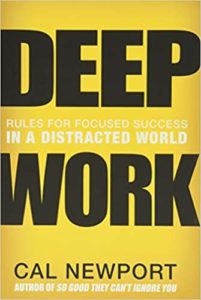Cal Newport writes well for a computer scientist. He avoids the dry technical language typical of his academic discipline. And although he doesn’t display flow charts or snippets of code, he does tend to present things in lists.
Given his background in logic, Deep Work is surprisingly vague. It’s not so much a problem of style as content. He tells personal stories, describes settings, and cites examples of other people. He tries his best to make it a good read. But his arguments are not convincing because the material is fuzzy.
It doesn’t help that the premise can easily be missed. Introductions for many books can and are skipped. But the very basis of Cal Newport’s Deep Work is explained in the introduction. Deep work is composed of activities done with distraction-free concentration. This would include thinking and activities that creates something of value, improves a skill and/or is hard to replicate.
The reasons for deep work are argued in Part 1. Deep work is valuable, rare and meaningful. Regrettably, there is no mention of whether everyone is capable of deep work, whether deep work is teachable or how you know you’re doing deep work. It is not clear whether deep work is a commonality that anyone can do or an assertion of an elitist exclusivity.
Although his premise is vague, Newport is not remiss in making suggestions for application. It may not be clear what deep work is, and who can do it, but Part 2 of the book describes four rules for doing deep work. Like the underlying nature of deep work, the rules are rather general and vaguely philosophical. We are to work deeply, embrace boredom, quit social media and drain the shallows.
In Rule 1, Newport identifies six strategies for working deeply. Unfortunately, they aren’t much better defined than the general admonition to just do it: work deeply.
First, decide on philosophy of depth. Second, ritualize. Third, make grand gestures. Fourth, don’t work alone.
Not much clearer, is it?
Maybe a bit more about depth philosophy will help. There are four philosophies of depth to choose from: monastic (hide from everyone), bimodal (have a city house and a country house), rhythmic (also called a chain method or habit), journalistic (work whenever you can).
These four choices are a false set of options. Most people don’t have the luxury of choosing. Living alone is not a likely choice. Having two locations to work (one for deep work and one for shallow) is a great alternative for rich people. Working when you can is not much of a plan, which leaves us with developing a daily habit of deep work. Fortunately, this is the plan Newport uses himself. Probably just coincidence.
“Ritualizing” is not about how to establish a habit of deep work. Instead, it is about the auxiliary things it takes to make. It takes him quite a few pages to say that you should start your day with a good cup of coffee. Cardiologists will be glad to know that although he means it literally for himself, he means it metaphorically for others.
Making Grand Gestures is an injunction to announce your big goals to others, as an aid to motivation. Don’t Work Alone contains an attack on open floor plans for work environments because distraction destroys depth. He recommends spoke and hub architecture so you can hide in your spoke when you wish and collaborate with others in the hub when that activity suits you.
Execute Like A Business applies the Four Disciples of Execution (a book by Chris McChesney, Jim Huling, and Sean Covey) to deep thinking. These four principles (focus on the important, use lead measures, keep a scoreboard, regular team accountability meetings) are rehashed but not thoroughly expanded. No new insights emerged, unless you haven’t considered using lead measures (input measures, such as amount of time spent) instead of follow measures (outcome measures, such as sales or the number of widgets cranked).
Be Lazy provides three reasons for downtime (increasing insights, energy and effectiveness).
The rest of the book is about the same.
Rule 2 (embracing boredom) advocates limiting your access to the internet, giving yourself hard deadlines (emulate Teddy Roosevelt), meditate productively (what psychologists would call incubation), identify next steps (aka, David Allen) and memorize a deck of card (in a sort of train-your-brain way).
Rule 3 is to quite social media. There is a good description of haymaking (literally). And a comparison between any-benefit investment and the craftsman investment approach. Essentially, we should identify high-level goals, and select activities which help us make progress on our goals.
Rule 4 is to de-emphasize shallow in favor of deep work. We do that by treating time with respect. Instead of letting come what may, we should schedule every minute of the day by allocating blocks of time to specific tasks. Deep work won’t happen is we don’t schedule it. By increasing the effectiveness of our work day, we can stop work by 5:30 and not think of it again until the next day.
Newport provides come good suggestions for handling email, managing time and fulfilling both personal and corporate needs. Ignore the vagueness of his general concept and choose among the many tips provided. Try out whatever speaks to your heart.
